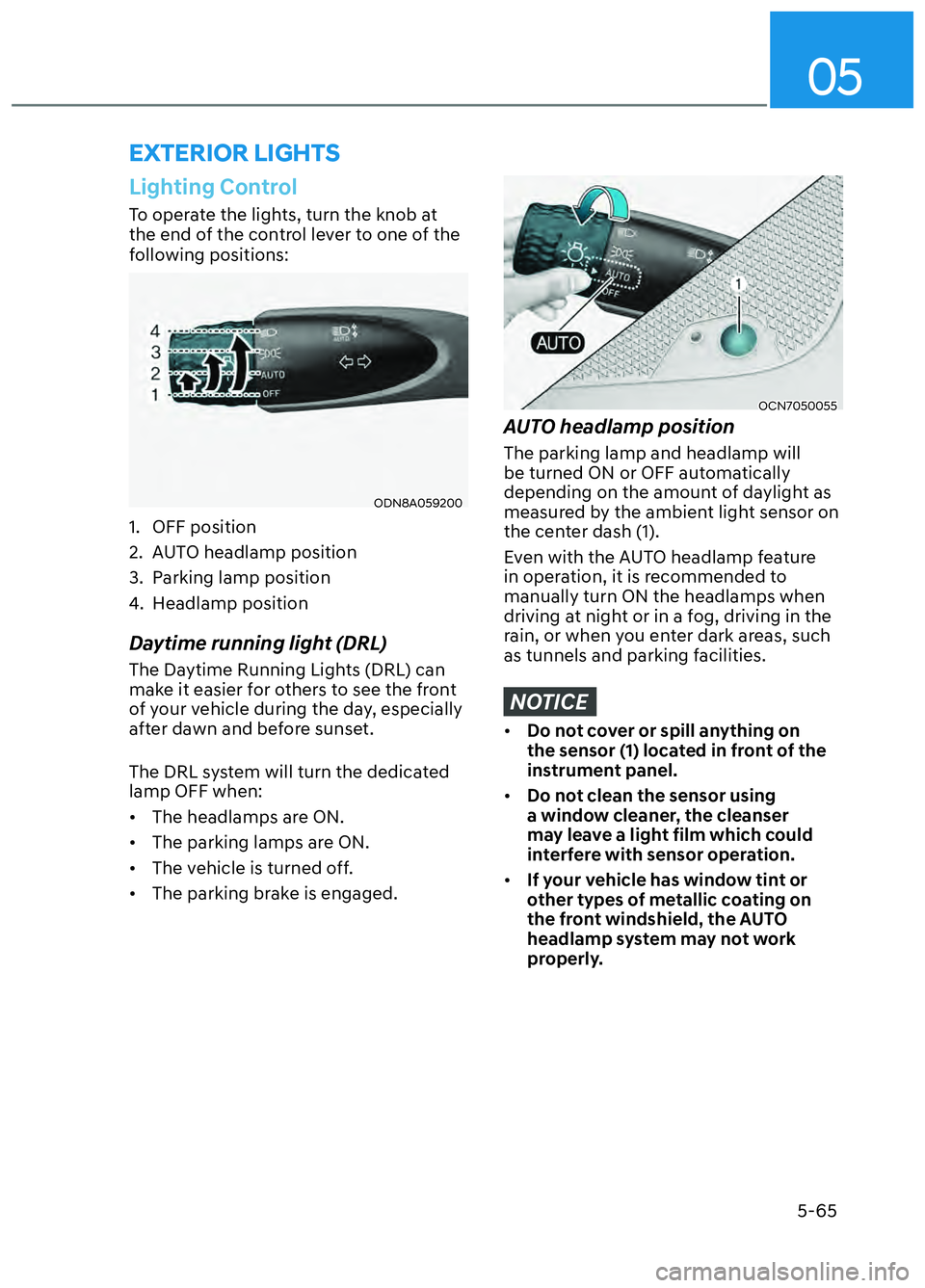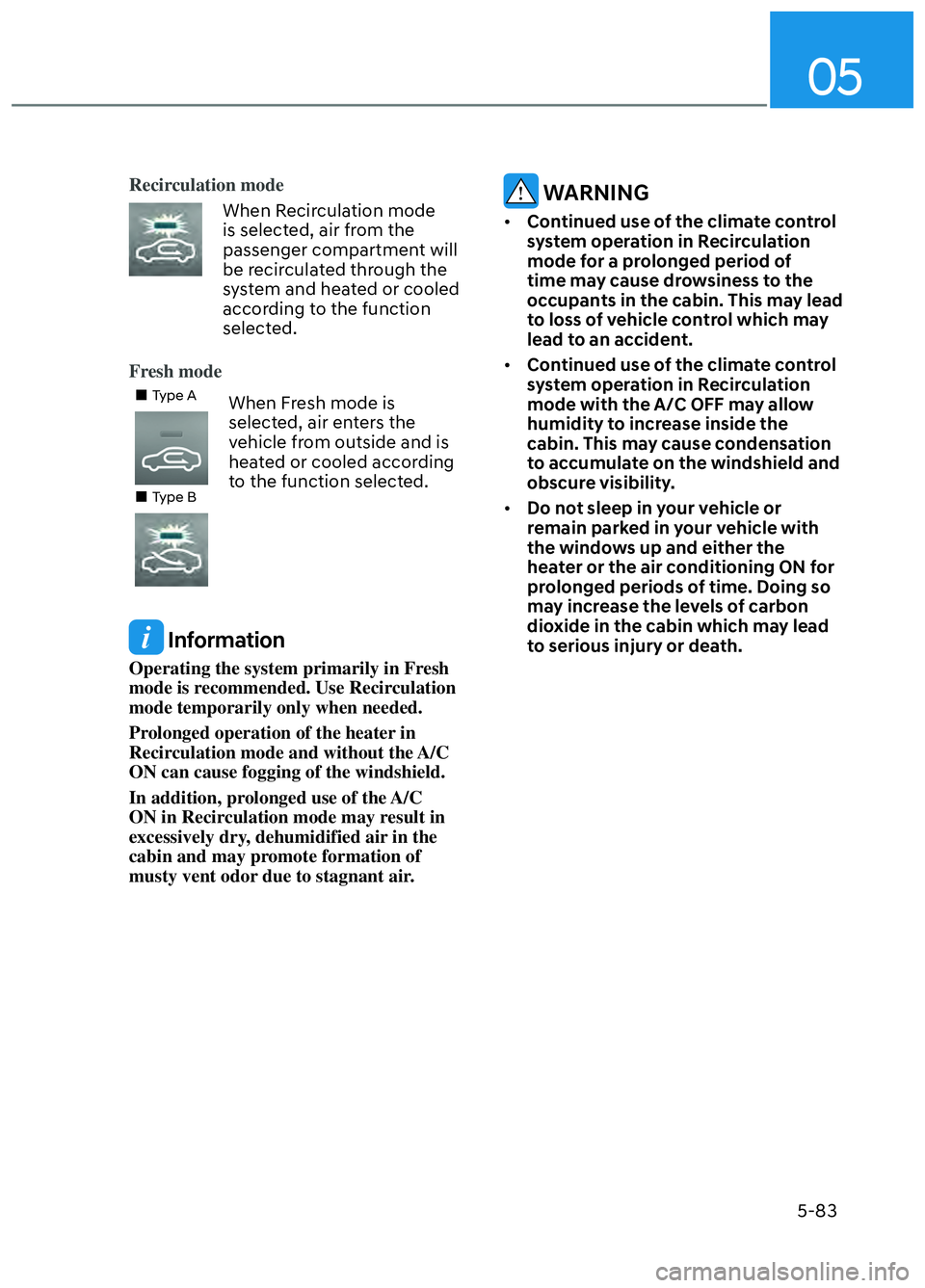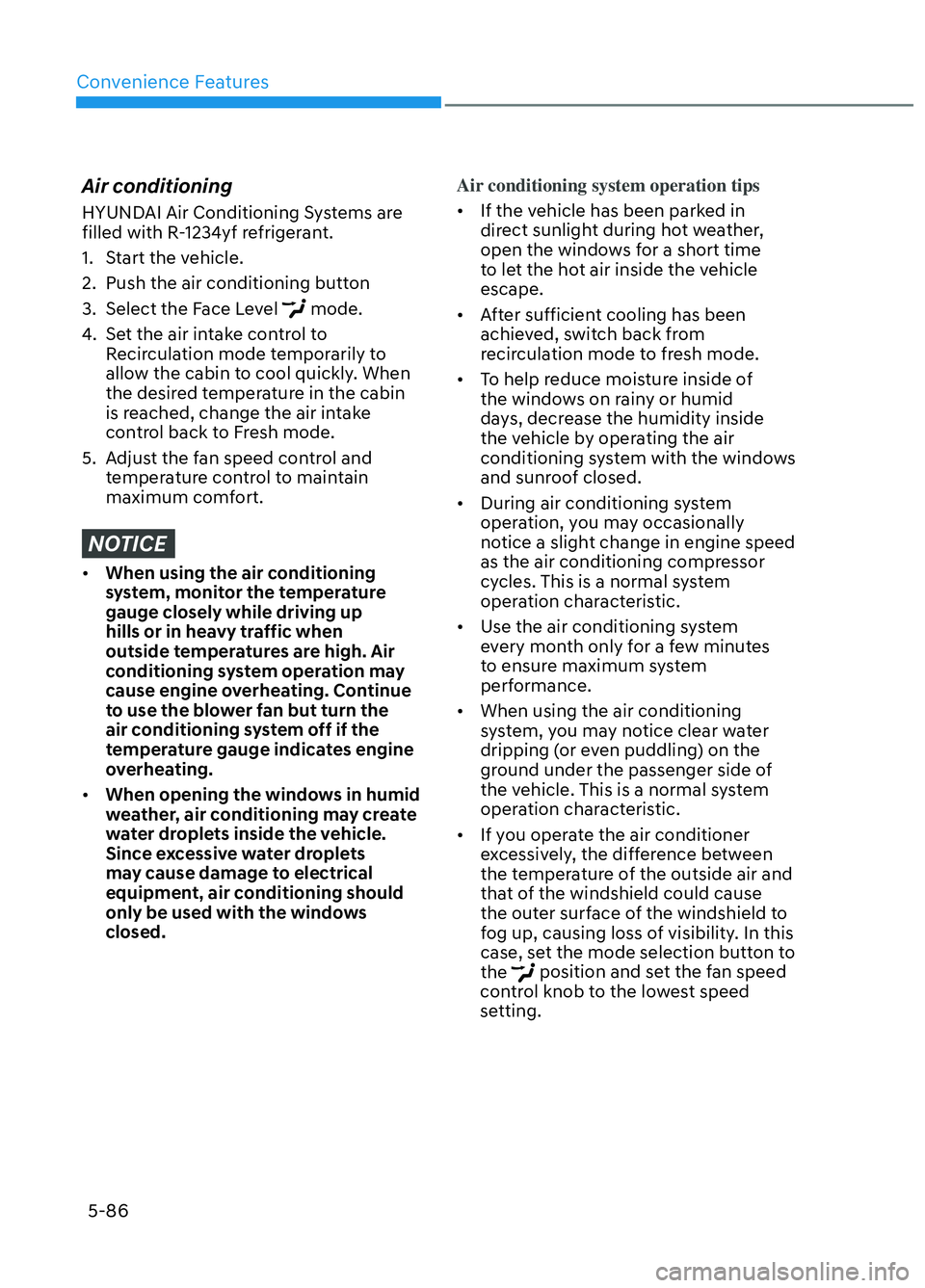Page 187 of 506

05
5-65
EXTERIOR LIGHTS
Lighting Control
To operate the lights, turn the knob at
the end of the control lever to one of the
following positions:
ODN8A059200ODN8A059200
1. OFF position
2. AUTO headlamp position
3. Parking lamp position
4. Headlamp position
Daytime running light (DRL)
The Daytime Running Lights (DRL) can
make it easier for others to see the front
of your vehicle during the day, especially
after dawn and before sunset.
The DRL system will turn the dedicated
lamp OFF when:
• The headlamps are ON.
• The parking lamps are ON.
• The vehicle is turned off.
• The parking brake is engaged.
OCN7050055OCN7050055
AUTO headlamp position
The parking lamp and headlamp will
be turned ON or OFF automatically
depending on the amount of daylight as
measured by the ambient light sensor on
the center dash (1).
Even with the AUTO headlamp feature
in operation, it is recommended to
manually turn ON the headlamps when
driving at night or in a fog, driving in the
rain, or when you enter dark areas, such
as tunnels and parking facilities.
NOTICE
• Do not cover or spill anything on
the sensor (1) located in front of the
instrument panel.
• Do not clean the sensor using
a window cleaner, the cleanser
may leave a light film which could
interfere with sensor operation.
• If your vehicle has window tint or
other types of metallic coating on
the front windshield, the AUTO
headlamp system may not work
properly.
CN7 N HMA 5.indd 5-65 2021-09-06 �� 3:06:33
Page 200 of 506
Convenience Features5-78
MANUAL CLIMATE CONTROL SYSTEM (IF EQUIPPED)
Type AType A
OCN7050100NOCN7050100N
Type BType B
OCN7050101NOCN7050101N
1. Fan speed control knob
2. Temperature control knob
3. Mode selection knob
4. Front windshield defroster position
5. Rear window defroster button
6. Air intake control button
7. A/C (Air conditioning) button
CN7 N HMA 5.indd 5-78 2021-09-06 �� 3:06:37
Page 203 of 506

05
5-81
OCN7050102OCN7050102
The mode selection knob controls the
direction of the air flow through the
ventilation system.
Air can be directed to the floor,
dashboard outlets, or windshield. Five
symbols are used to represent Face, Bi-
Level, Floor, Floor-Defrost and Defrost air
position.
Face-Level (B, D)
Air flow is directed toward the upper
body and f
ace. Additionally, each outlet
can be controlled to direct the air
discharged from the outlet.
Bi-Level (B, C, D, E)
Air flow is directed towards the face and
the floor
.
Floor-Level (A, C, D, E)
Most of the air flow is directed to the
floor
, with a small amount of the air
being directed to the windshield and side
window defrosters.
Floor & Defrost (A, C, D, E)
Most of the air flow is directed to the
floor and the windshield with a small
amoun
t directed to the side window
defrosters.
Defrost-Level (A, D)
Most of the air flow is directed to the
windshield with a small amoun
t of air
directed to the side window defrosters.
OCN7050104OCN7050104
MAX A/C-Level (B, D) (if equipped)
The MAX A/C mode is used to cool the
inside o
f the vehicle faster. Air flow is
directed toward the upper body and
face.
In this mode, the air conditioning and
the recirculated air position cannot be
selected. Turn the fan speed mode to
adjust.
CN7 N HMA 5.indd 5-81 2021-09-06 �� 3:06:38
Page 205 of 506

05
5-83
Recirculation mode
When Recirculation mode
is selected, air from the
passenger compartment will
be recirculated through the
system and heated or cooled
according to the function
selected.
Fresh mode
Type AType AWhen Fresh mode is
selected, air enters the
vehicle from outside and is
heated or cooled according
to the function selected.
Type BType B
Information
Operating the system primarily in Fresh
mode is recommended. Use Recirculation
mode temporarily only when needed.
Prolonged operation of the heater in
Recirculation mode and without the A/C
ON can cause fogging of the windshield.
In addition, prolonged use of the A/C
ON in Recirculation mode may result in
excessively dry, dehumidified air in the
cabin and may promote formation of
musty vent odor due to stagnant air.
WARNING
• Continued use of the climate control
system operation in Recirculation
mode for a prolonged period of
time may cause drowsiness to the
occupants in the cabin. This may lead
to loss of vehicle control which may
lead to an accident.
• Continued use of the climate control
system operation in Recirculation
mode with the A/C OFF may allow
humidity to increase inside the
cabin. This may cause condensation
to accumulate on the windshield and
obscure visibility.
• Do not sleep in your vehicle or
remain parked in your vehicle with
the windows up and either the
heater or the air conditioning ON for
prolonged periods of time. Doing so
may increase the levels of carbon
dioxide in the cabin which may lead
to serious injury or death.
CN7 N HMA 5.indd 5-83 2021-09-06 �� 3:06:39
Page 208 of 506

Convenience Features5-86
Air conditioning
HYUNDAI Air Conditioning Systems are
filled with R-1234yf refrigerant.
1. Start the vehicle.
2. Push the air conditioning button
3. Select the Face Level
mode.
4. Set the air intake control to Recirculation mode temporarily to
allow the cabin to cool quickly. When
the desired temperature in the cabin
is reached, change the air intake
control back to Fresh mode.
5. Adjust the fan speed control and temperature control to maintain
maximum comfort.
NOTICE
• When using the air conditioning
system, monitor the temperature
gauge closely while driving up
hills or in heavy traffic when
outside temperatures are high. Air
conditioning system operation may
cause engine overheating. Continue
to use the blower fan but turn the
air conditioning system off if the
temperature gauge indicates engine
overheating.
• When opening the windows in humid
weather, air conditioning may create
water droplets inside the vehicle.
Since excessive water droplets
may cause damage to electrical
equipment, air conditioning should
only be used with the windows
closed. Air conditioning system operation tips
• If the vehicle has been parked in
dir
ect sunlight during hot weather,
open the windows for a short time
to let the hot air inside the vehicle
escape.
• After sufficient cooling has been achieved, switch back from
recirculation mode to fresh mode.
• To help reduce moisture inside of the windows on rainy or humid
days, decrease the humidity inside
the vehicle by operating the air
conditioning system with the windows
and sunroof closed.
• During air conditioning system operation, you may occasionally
notice a slight change in engine speed
as the air conditioning compressor
cycles. This is a normal system
operation characteristic.
• Use the air conditioning system every month only for a few minutes
to ensure maximum system
performance.
• When using the air conditioning system, you may notice clear water
dripping (or even puddling) on the
ground under the passenger side of
the vehicle. This is a normal system
operation characteristic.
• If you operate the air conditioner excessively, the difference between
the temperature of the outside air and
that of the windshield could cause
the outer surface of the windshield to
fog up, causing loss of visibility. In this
case, set the mode selection button to
the
position and set the fan speed
control knob to the lowest speed
setting.
CN7 N HMA 5.indd 5-86 2021-09-06 �� 3:06:41
Page 211 of 506
05
5-89
AUTOMATIC CLIMATE CONTROL SYSTEM (IF EQUIPPED)
OCN7050110LOCN7050110L
1. Driver’s temperature control knob
2. Passenger’s temperature control knob
3. AUTO (automatic control) button
4. SYNC button
5. OFF button
6. Front windshield defroster button
7. Air conditioning button
8. Air intake control button
9. Rear window defroster button
10. Fan speed control button
11. Mode selection button
12. Climate control information screen
CN7 N HMA 5.indd 5-892021-09-06 �� 3:06:42
Page 215 of 506
05
5-93
OCN7050115OCN7050115
The mode selection toggle switch
controls the direction of the air flow
through the ventilation system.
The air flow outlet direction is cycled as
follows:
Face-level (B, D)
Air flow is directed toward the upper
body and f
ace. Additionally, each outlet
can be controlled to direct the air
discharged from the outlet.
Bi-Level (B, C, D, E)
Air flow is directed towards the face and
the floor
.
Floor-Level (A, C, D, E)
Most of the air flow is directed to the
floor
, with a small amount of the air
being directed to the windshield and side
window defrosters.
Floor & Defrost (A, C, D, E)
Most of the air flow is directed to the
floor and the windshield with a small
amoun
t directed to the side window
defrosters.
CN7 N HMA 5.indd 5-93 2021-09-06 �� 3:06:43
Page 216 of 506
Convenience Features5-94
OCN7050116OCN7050116
Defrost-Level (A, D)
Most of the air flow is directed to the
windshield with a small amoun
t of air
directed to the side window defrosters.
OCN7N051106OCN7N051106
Instrument panel vents
The instrument panel vent air flow can be
dir
ected up/down or left/right using the
vent adjustment lever.
To close the vent, push the air vent
lever in the opposite direction of the
passenger. To open the vent, push the
air vent lever in the same direction of the
passenger.
Temperature control
Driver’s seatDriver’s seatPassenger’s seatPassenger’s seat
OCN7050114OCN7050114
The temperature will increase by turning
the knob to the right.
The temperature will decrease by turning
the knob to the left.
The temperature will increase or
decrease by 1°F (0.5°C) for each
incremental location. When set to the
lowest temperature setting, the air
conditioning will operate continuously.
CN7 N HMA 5.indd 5-94 2021-09-06 �� 3:06:43